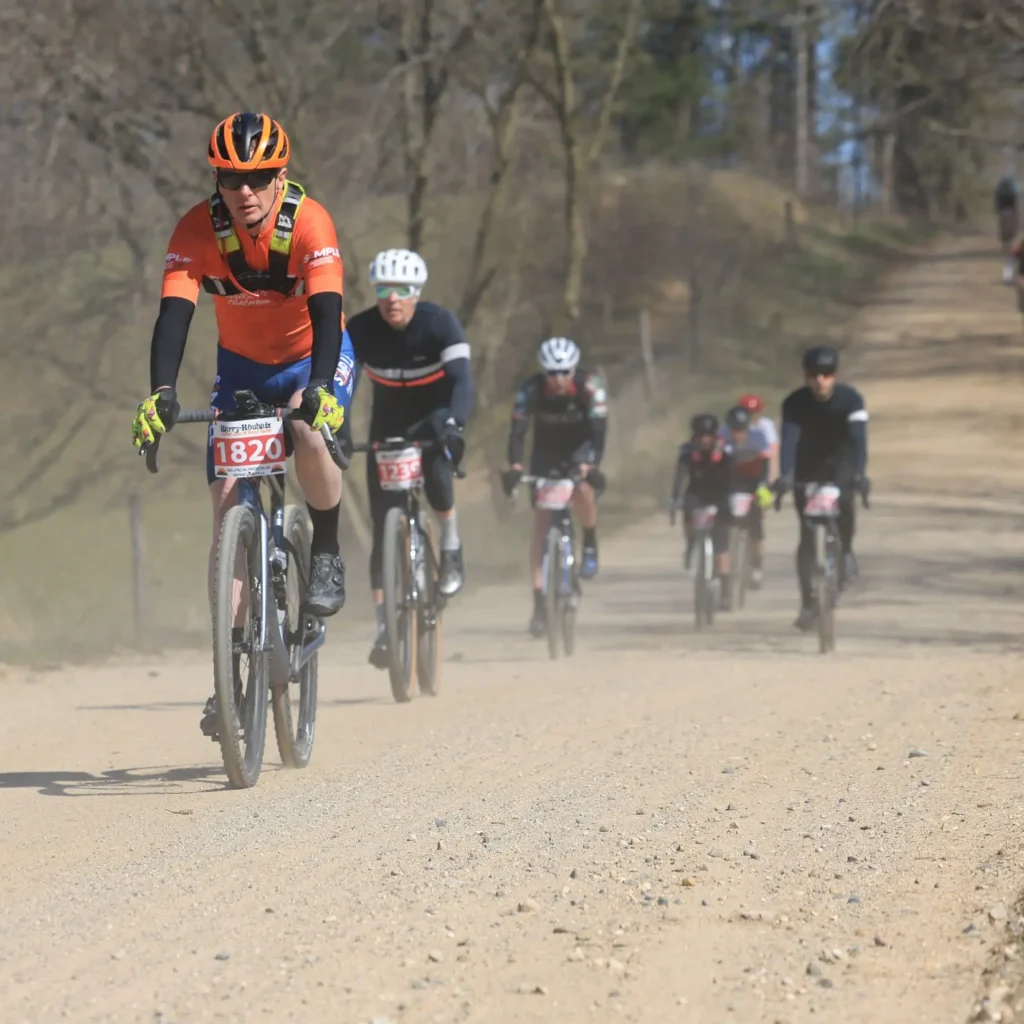Improve Your Threshold Power to Improve Your Gravel Cycling Speed and Comfort
Gravel racing on bicycles requires building as big an FTP, or functional threshold power, as possible in order to maintain your power during long races.
Most of the time, gravel races are between 30 and several hundred miles.
As an older guy, I stick with the 50 to 70-mile races at a maximum and let others have fun with the long events.
But all of us need a big FTP, which means we need to build up our aerobic capacity to ride at a bigger power for longer.
FTP is generally defined as the maximum power you can sustain for an hour. More on this later.

Lactate production is good – until it’s too much
First of all, some general and simplified physiology.
As you increase the intensity of your exercise, more glycogen is burned as fuel to produce the energy you need.
One of the products of that glycogen burning is lactate.
The more intensity, the more lactate is produced.
That’s why lactate – formerly known as “lactic acid” – was thought to be what caused the burning feeling in your muscles.
Actually, lactate is a by-product that is also a fuel.
Under your lactate threshold or Maximum Lactate Steady State, your body is using all the lactate that is produced.
However, over the threshold, and there is more lactate produced than can be used.
A higher lactate threshold = higher speed with fewer watts
Obviously, the more power we can put out at a lower lactate production will help our endurance performance.
The ability to sustain high levels of work output without crossing this threshold is critical for endurance athletes like gravel cyclists who need to maintain high power outputs for long periods.
Improving your lactate threshold means that you can ride faster and harder before hitting that wall where too much lactate accumulates and your body can’t handle the processing.
Power at lactate threshold is similar to FTP
FTP and lactate threshold are both important metrics to consider when it comes to improving your performance in gravel cycling races.
FTP (Functional Threshold Power) is roughly the highest power output you can maintain for one hour without fatigue.
It is commonly used as a benchmark for training and racing efforts in cyclists, even though its accuracy is limited.
Typically, you get your FTP level by doing a 20-minute all-out test, then taking around 95 percent of that number as your FTP.
Remember, this is an estimate of an estimate so you’re better off being conservative in your number.
FTP specifically measures sustainable power output over time while lactate threshold relates more directly to how well your body can handle high-intensity efforts.
The power at your lactate threshold is roughly correlated to your FTP.
In terms of training, improving either metric will likely result in improved overall performance on the bike.
Training to improve your lactate threshold is crucial for gravel cycling
Gravel racing requires a high level of endurance and sustained effort over long periods of time.
The ability to remove lactate from the muscles efficiently is key in order to maintain a higher intensity for longer.
Gravel races often consist of challenging terrains such as steep climbs and descents which require strong legs and lungs.
Plus gravel races are often long, depending on the distance you choose.
Your ability to produce power over prolonged periods directly affects your success.
Therefore, by increasing your lactate threshold through targeted training sessions, you’ll be better equipped to tackle those hills with greater ease.
It’s important to note that consistency is key when it comes to improving lactate threshold. Incorporating these types of workouts into your regular routine on a consistent basis will yield the most significant results over time.
One way to improve FTP is lots of threshold intervals
One way to build your FTP is by doing threshold intervals just under your FTP.
The intensity of threshold intervals should be at or near your lactate threshold.
This intensity is typically around 90 to 95% of your FTP or roughly equivalent to your time trial pace.
These intervals help to improve your lactate threshold by gradually increasing your body’s tolerance to lactate build-up and improving your body’s ability to clear it.
The key to effective threshold intervals is to gradually increase the intensity and duration over time.
It is important to accurately determine your lactate threshold before starting threshold intervals as the intensity should be specific to your individual fitness level.
It is also recommended to work with a coach or use a lactate threshold test to determine your specific threshold intensity, as this will help to ensure that the intervals are challenging enough to provide a training stimulus, but not so difficult that you are unable to complete the intervals.
This is kind of the key: You never want to break yourself in these intervals.
You should always finish with the feeling you could do more.
A second way to increase FTP is through HIIT
The other main way of increasing your FTP is through high-intensity interval training (HIIT).
In the 2021 article “Polarized Training vs HIIT Training vs Threshold Training” by Andrew Coggan, PhD, he argues high-intensity interval training (HIIT) can be effective in improving FTP and lactate threshold
However, he says HIIT it may not be as efficient as polarized training, which involves spending most of your time riding below your FTP and then incorporating short bouts of high-intensity efforts.
Coggan cites several studies that have found polarized training to be more effective than HIIT alone in improving these performance metrics.
In a 2015 review article titled “The Effectiveness of High-Intensity Interval Training for the Rehabilitation of Coronary Artery Disease Patients” by Maureen MacDonald, PhD, the author discusses how HIIT has been shown to be effective in improving aerobic capacity in cardiac patients, but also notes that HIIT may not be the best approach for everyone.
MacDonald points out that some individuals may experience excessive fatigue and injury risk with HIIT, and that steady-state training may be a better option for certain populations.
Overall, while HIIT can be effective in improving FTP and lactate threshold in cyclists, it may not be the most efficient or sustainable method for everyone.
Incorporating polarized training or steady-state training may be more appropriate depending on individual goals and abilities.
Other ways to improve your FTP/Lactate Threshold
- Gradually increasing the duration of your easy endurance rides can help to build up your endurance and improve your lactate threshold.
- Riding gravel or rough terrain in training rides can improve your bike handling ability, which will make it easier to navigate the tough stuff during a race.
- In addition to structured training, nutrition plays a crucial role in improving your FTP. Eating a well-balanced diet with adequate protein, carbohydrates, healthy fats, vitamins and minerals can help fuel your body during intense workouts and aid recovery post-workout.
- Strength training is another key to success in gravel racing and building your FTP. If you are full-body strong, particularly in your core and hips, your muscles will be better able to withstand the stress of racing.
- Further, giving yourself enough rest and recovery time between workouts is important for making progress towards increasing your FTP. You only make progress in your FTP with rest and recovery.
Three things to know about increasing your FTP for gravel racing:
- Do most of your training as easy endurance rides. Because you can stack endurance rides with less fatigue than hard intervals, you can get a lot of adaptations that improve FTP.
- Do a variety of HIIT and threshold work to improve your FTP.
- Make sure your nutrition and recovery are dialed in to help you utilize all the work you’ve done.
Need more about gravel cycling?
Sign up for Virtual Coffee so we can discuss your goals, ask questions, and talk about making your endurance training more effective, fun, and Simple. It’s completely free!
Get a free Core Strength and Stability training video when you opt-in to receive my weekly blog posts about what works in endurance sports.
Paul Warloski is a:
- USA Cycling Level 3 Coach
- RRCA Running Coach
- Training Peaks Level 2 Coach
- RYT-200 Yoga Instructor
- Certified Personal Trainer




